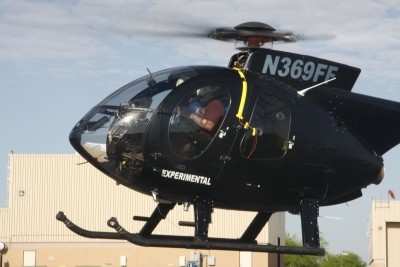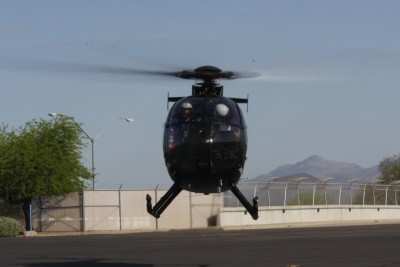First Flight Completed By Van Horn Aviation
Rotor blade manufacturer Van Horn Aviation (VHA) successfully
completed a series of ground and flight tests of its composite MD
500 main rotor blades during a four-hour test session at the MD
Helicopters Inc. (MDHI) facility in Mesa, Arizona aboard a MD 530F
test aircraft. According to VHA president James R. Van Horn, the
April 7, 2011 flight test featured the first commercially-developed
composite main rotor blades flown on the MD 500 series helicopter
since the aircraft was first developed as the Hughes 369 in
1963.

Composite Rotor Blade Test Flight
"This flight test marks a significant step forward in increasing
the capability of a well-respected and productive helicopter," said
Van Horn. "Our goals in replacing the current metal blades with
more efficient composite blades include increasing the helicopter's
internal gross weight and nearly tripling the blade life limit
while also decreasing aircraft fuel burn rates, overall aircraft
noise and direct operating costs."
Greg Ashe, a retired Boeing experimental test pilot who served
as the project test pilot on the Hughes 369F model and has more
than 800 experimental flight test hours in the MD 500 series,
performed all of the ground and flight tests with assistance from
VHA and MDHI ground crew. The test session had three distinct
parts: track and balance of the VHA blades, hover tests, and
low-speed forward flight. "(T)he composite blades performed well
enough in initial ground and hover tests to take the aircraft into
low-speed forward flight on the blade's first flight test," said
Van Horn, a former U.S. Army instructor pilot who served as flight
test engineer on the VHA MD 500 test session. "Our blades are very
stable, even through transitional flight."
The flight test followed a static pull test performed at VHA's
Tempe, AZ, facility on March 28, which showed the composite blade
could withstand static load of more than 47,000 lbs. The static
pull test provided confidence in moving forward with the flight
test program. "Another program goal is to create a blade for the MD
500 series that's easier to track and balance," said Van Horn. "We
were able to track and balance our blades in a minimum of
iterations. The blades responded as expected when trim tab or pitch
link changes were made, and they were resonance-free through the
entire RPM range."

The VHA MD 500 main rotor blade shares the same NASA-designed
laminar flow airfoil, shaped tip, and composite structure as VHA's
successful 206B/L composite tail rotor blade, which received a
Supplemental Type Certificate from the Federal Aviation
Administration in September 2009 and has been in production since.
One of the features of the VHA 206B/L blade is reduced overall
aircraft noise, and the initial flight of the VHA MD 500 blades
seem to confirm that the new main rotor blades will significantly
reduce the overall aircraft noise as well.
"You can hear the difference between the metal and VHA composite
blades even at a hover," said VHA general manager Dean Rosenlof,
who was one of six VHA employees on hand to witness the flight
test.
The April 7 flight test confirms the blade's design, which was
built with prototype tooling. Over the next few weeks, VHA
personnel will design and build the production tooling required to
manufacture conformed blades for FAA certification testing.
Flight testing is estimated to resume with conformed blades in
third quarter 2011.
 Classic Aero-TV: The Switchblade Flying Car FLIES!
Classic Aero-TV: The Switchblade Flying Car FLIES! ANN FAQ: Q&A 101
ANN FAQ: Q&A 101 ANN's Daily Aero-Term (04.12.24): Discrete Code
ANN's Daily Aero-Term (04.12.24): Discrete Code ANN's Daily Aero-Term (04.13.24): Beyond Visual Line Of Sight (BVLOS)
ANN's Daily Aero-Term (04.13.24): Beyond Visual Line Of Sight (BVLOS) ANN's Daily Aero-Linx (04.13.24)
ANN's Daily Aero-Linx (04.13.24)




